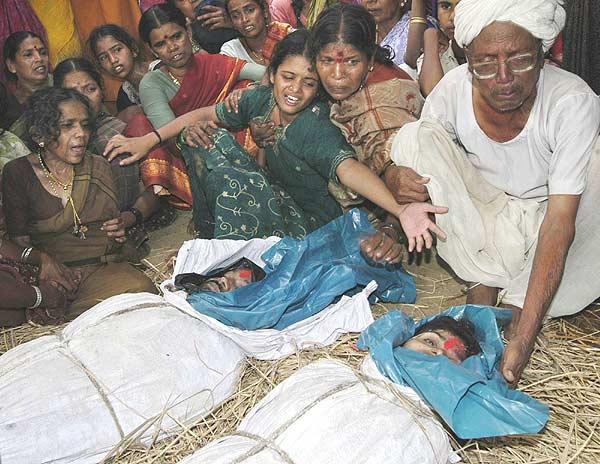
By P Sainath, Counterpunch
Suicide rates among Indian farmers were a chilling 47 per cent higher than they were for the rest of the population in 2011. In some of the States worst hit by the agrarian crisis, they were well over 100 per cent higher. The new Census 2011 data reveal a shrinking farmer population. And it is on this reduced base that the farm suicides now occur.
Apply the new Census totals to the suicide data of the National Crime Records Bureau (NCRB) and the results are grim. Sample: A farmer in Andhra Pradesh is three times more likely to commit suicide than anyone else in the country, excluding farmers. And twice as likely to do so when compared to non-farmers in his own State. The odds are not much better in Maharashtra, which remained the worst State for such suicides across a decade.
“The picture remains dismal,” says Prof. K. Nagaraj, an economist at the Asian College of Journalism, Chennai. Prof. Nagaraj’s 2008 study on farm suicides in India remains the most important one on the subject. “The intensity of farm suicides shows no real decline,” he says. “Nor do the numbers show a major fall. They remain concentrated in the farming heartlands of five key States. The crisis there continues. And the adjusted farmers’ suicide rate for 2011 is in fact slightly higher than it was in 2001.” And that’s after heavy data fudging at the State level.
Five States account for two-thirds of all farm suicides in the country, as NCRB data show. These are Maharashtra, Andhra Pradesh, Karnataka, Madhya Pradesh and Chhattisgarh. The share of these ‘Big 5’ in total farm suicides was higher in 2011 than it was in 2001. At the same time, the new Census data show that four of these States have far fewer farmers than they did a decade ago. Only Maharashtra reports an increase in their numbers.
Nationwide, the farmers’ suicide rate (FSR) was 16.3 per 100,000 farmers in 2011. That’s a lot higher than 11.1, which is the rate for the rest of the population. And slightly higher than the FSR of 15.8 in 2001.
In Maharashtra, for instance, the rate is 29.1 suicides per 100,000 farmers (‘Main cultivators’). Which is over 160 per cent higher than that for all Indians excluding farmers. Such gaps exist in other States, too. In as many as 16 of 22 major States, the farm suicide rate was higher than the rate among the rest of the population (RRP) in 2011.
The data for 2011 are badly skewed, with States like Chhattisgarh declaring ‘zero’ farm suicides that year. The same State reported an increase in total suicides that same year. But claimed that not one of these was a farmer. What happens if we take the average number of farm suicides reported by the State in three years before 2011? Then Chhattisgarh’s FSR is more than 350 per cent higher than the rate among the rest of the country’s population.
In 1995, the ‘Big 5’ accounted for over half of all farm suicides in India. In 2011, they logged over two-thirds of them. Given this concentration, even the dismal all-India figures tend to make things seem less terrible than they are.
Ten States show a higher farm suicide rate in 2011 than in 2001. That includes the major farming zones of Punjab and Haryana. The average farm suicide rate in the ‘Big 5’ is slightly up, despite a decline in Karnataka. And also a fall in Maharashtra. The latter has the worst record of any State. At least 53,818 farmers’ suicides since 1995. So how come it shows a lower FSR now?
Well, because Census 2011 tells us the State has added 1.2 million farmers (‘main cultivators’) since 2001. That’s against a nationwide decline of 7.7 million in the same years. So Maharashtra’s farm suicide rate shows a fall. Yet, its farm suicide numbers have not gone down by much. And a farmer in this State is two-and-a-half times more likely to kill himself than anyone else in the country, other than farmers.
Karnataka, in 2011, saw a lot less of farm suicides than it did a decade ago. And so, despite having fewer farmers than it did in 2001, the State shows a lower FSR. Yet, even the ‘lower’ farm suicide rates in both Maharashtra and Karnataka are way above the rate for the rest of the country.
These figures are obtained by applying the new farm population totals of Census 2011 to farm suicide numbers of the NCRB. The Census records cultivators. The police count suicides. In listing suicides, the State governments and police tend to count only those with a title to land as farmers.
“Large numbers of farm suicides still occur,” says Prof. Nagaraj. “Only that seems not to be recognised, officially and politically. Is the ‘conspiracy of silence’ back in action?” A disturbing trend has gained ground with Chhattisgarh’s declaration of ‘zero’ farm suicides. (That’s despite having had 4,700 in 36 months before the ‘zero’ declaration). Puducherry has followed suit. Others will doubtless do the same. Punjab and Haryana have in several years claimed ‘zero’ women farmers’ suicides. (Though media and study reports in the same years suggest otherwise). This trend must at some point fatally corrupt the data.
At least 270,940 Indian farmers have taken their lives since 1995, NCRB records show. This occurred at an annual average of 14,462 in six years, from 1995 to 2000. And at a yearly average of 16,743 in 11 years between 2001 and 2011. That is around 46 farmers’ suicides each day, on average. Or nearly one every half-hour since 2001.
P. SAINATH is the rural affairs editor of The Hindu, where this piece appears, and is the author of Everybody Loves a Good Drought. He can be reached at: [email protected].

